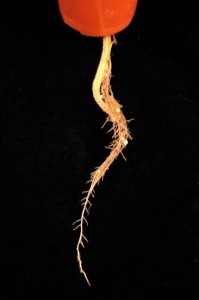African violets before and after wick watering
 Basic rules applied before wicking the plant:
Basic rules applied before wicking the plant:
Ideal for wick-watered African violets is the substrate composed of perlite, vermiculite and peat in equal parts. Unfortunately, vermiculite is hard to find for sale. As a result, the soil substrate can be modified. Soil from under the nettles will be used, tei, birch or hornbeam. Add 1 tablespoon of calcium carbonate to a pot with the given humus, 1 tablespoon of superphosphate, 2-3 glasses of burnt charcoal from the barbecue, 5-6 glasses of river sand and 4-5 glasses of sfagnum.
All components mix well and leave to infuse for 1-2 hours.
The main requirement is that the resulting soil mixture is aerated, brittle and afanat, with an acidity within the limits of 6.6-6.8.
The plant planted in this mixture will get wet with plenty of warm water. African violets who love shade will sit on tanks of 500 ml, those who love light – 800 ml, and the pots with miniature violets are placed on tanks of 100-150 ml.
The tank will be filled with warm water and status 2-3 times a month, for miniature violets a little more often. In the water with which the plants are watered will be added a few drops of vinegar / 1 l of water to prevent the salinity and alkalinity of the soil mixture.
Once they are watered through the wick, African violets need extra nourishing substances. To stimulate growth and flowering, the ideal is vitaflora nutritional solution.
Basic rules applied after the period of watering by wick of the plant:
African violets grow and develop by wick only for a determined period of time. Only young plants will be planted and placed on the wick (6-8) months, with healthy and well-developed rosettes and roots.
Once passed to watering through the wick, they will bloom in the shortest time.
After almost a year ( from spring to spring), the white roots of the plant cover the wick and reach the tank with water. The rosette will look good (depends on the conditions), instead the strain may have a less aesthetic appearance, due to loss of leaves.
In this case, African violet will be removed from the pot carefully, without touching or undoing the 'lump' of roots, cut the wick and plant violet in a pot with a diameter of 11-12 cm, with wick. Around the roots is put the mixture of earth.
For the violet in question will begin the second 'youth'. The plant quickly adapts to the nutrient-rich soil and exactly in a month it will bloom in abundance. This stage of violet's life is also called "exhibition".
Only african violets that have successfully passed the first stage of development on the wick reach their second youth. Less developed plants, whether it is planted in a new mixture of earth, whether they will root again, and if the plant is suspected of any infection is thrown away.
After the second stage, African violets will rejuvenate.
It is not recommended to keep in the collection African violets with an age of more than 3 years. Over time, various diseases may occur, Infections.
The same will not take leaves for multiplication from these specimens, the most suitable for propagation are leaves from specimens 2-3 years old.

